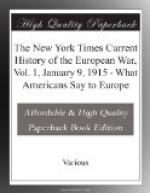Germany has claimed that England promised her support to Russia and France on July 30, or in the night of July 29, and, to prove it, has published the letter from the Belgian Minister in St. Petersburg to his Minister of Foreign Affairs, printed in translation in THE NEW YORK TIMES on Oct. 7. This letter, which has not been officially denied by the Allies, states that the promise of England’s support gave the Russian war party the upper hand and resulted in the order of complete mobilization.
English “White Paper’s” Testimony.
Strangely enough, and doubtless by an oversight, the English “White Paper” contains two dispatches (Nos. 80 and 106) which seem to confirm the accuracy of M. de l’Escaille’s statement, viz., that England promised the Russian-French combination her support.
On July 29 Sir Rennell Rodd wrote to Sir Edward Grey (No. 80) that the Italian Minister of Foreign Affairs had told him “there seemed to be a difficulty in making Germany believe that Russia was in earnest. As Germany, however, was really anxious for good relations with ourselves, if she believed that Great Britain would act with Russia and France, he thought it would have a great effect.”
In a later dispatch of the same day (No. 86) he deprecates Russia’s partial mobilization, which he fears has spoiled the chances of Germany’s exerting any pressure on Austria.
But on the next day, July 30, these remarkable words occur: “He [the Italian Minister] had reason to believe that Germany was now disposed to give more conciliatory advice to Austria, as she seemed convinced that we should act with France and Russia, and was most anxious to avoid issue with us.” (No. 106.)
Readers of the “White Paper” will look in vain for an explanation of such a change of heart on Germany’s part. What does “now” mean in the last letter? And why does Germany seem “convinced” that England will act with Russia—if not that she has heard of the promise mentioned by M. de l’Escaille, as given early on July 30 or late the 29th? The dates agree, and unless Sir Edward Grey publishes further papers to explain the change that had taken place between July 29 and July 30 one seems forced to accept this explanation.
What is Germany’s attitude? Does she rush into war? Not at all, for she is “most anxious to avoid issue” with England. (No. 106.) Germany knew that Russia had begun to mobilize. Every day, every hour counted; for against the masses of Russia she had only her greater speed to match. She knew that England had gone over to Russia, although she was probably hoping that the alliance between the Saxon and the Slav was not yet irrefragable. Still, the prospects were dark. But in spite of this the efforts were renewed to see what could be done in Vienna.




